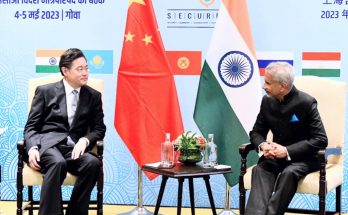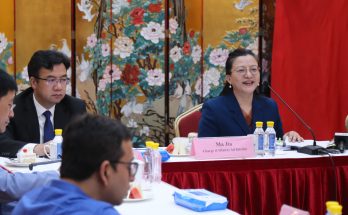
South China Sea has become a hot topic recently, making people confused about the situation. Many Indian friends have asked me a set of questions: What are facts on the South China Sea issue? Who has the sovereignty over the islands and reefs in that area? Who on earth raises the tension there? I would like to share with you the truth.
China was the first country that found, exploited and exercised sovereign jurisdiction on the Nansha Islands. China’s sovereignty over Nansha Islands is grounded on ample historical and jurisprudential evidence. There were only Chinese people living on the Nansha Islands until the late 19th century, which was recorded in the historical archives of many western countries.
During World War II, Japan invaded and occupied the Nansha Islands. After WWII, the Chinese government recovered the Nansha Islands, based on a series of international conventions and agreements including the Cairo Declaration and the Potsdam Proclamation. The Chinese government also reaffirmed its sovereignty by naming, mapping, administrating and troops stationing. Major countries including the US, Soviet Union, Japan and France acknowledged that the Nansha Islands are China’s territory. Japan pledged to abide by the relevant regulations in the Potsdam Proclamation and renounced all right and claims to Taiwan, the Pescadores, Nansha Islands and Xisha Islands. Some countries in that area had long acknowledged China’s sovereignty over Xisha Islands and Nansha Islands.
China shares land borders with 14 neighbouring countries, and has solved border issues with 12 of them through bilateral negotiation. Besides, China and Vietnam have demarcated the maritime border on the Beibu Gulf by negotiations. The border treaties and agreements are all based on the friendly consultation on an equal footing. Most of these countries are small or medium countries but none of them had any complaint on the process of demarcation negotiation. In fact, China has consistently adopted the route of bilateral negotiation and consultation to resolve the territory and demarcation issue. China has also accumulated rich experience from its long-term practice.
The Philippines’ unilateral move to push forward the arbitration proceedings seriously undermines the order of international maritime law. It is a political provocation under the cloak of law. Except the United States, which has so far not ratified the United Nations Convention on the Law of the Sea (UNCLOS), four of the five permanent members of the United Nations Security Council, including China, had submitted the declaration on Optional Exceptions, in accordance with Article 298 of UNCLOS. The Philippines broke not only its own promises of resolving the relevant dispute through negotiations and consultations, but also the Declaration on the Conduct of Parties in the South China Sea and the authority and sanctity of the Convention.
China is a responsible country in the international community. As the biggest country in the South China Sea area, China shoulders its international responsibilities and obligations. China’s construction on some islands and reefs of the South China Sea is aimed at better fulfilling its international obligations as well as improving the living standard of people living there. When the construction is finished, China will offer more public service to international community in the fields of search and rescue, disaster prevention and mitigation, meteorological observation, ecological conservation, navigation safety, etc. China’s deployment of necessary defensive facilities is different from the militarisation move conducted by some countries on the islands and reefs which were illegally occupied. In building defense facilities on our own islands and reefs, China is exercising its right to self-preservation under international law. China is not the first country to have deployed weapons in the Nansha; it’s not the country that has deployed the most weapons, and not the country that conducts the most frequent military activities. China cannot be accused of “militarization”; this label is more suited to some other countries.
China firmly upholds freedom of navigation and overflight by all countries in accordance with international law. There is no problem with freedom of navigation and overflight in the South China Sea. Every day, 15 million barrels of oil go through the Malacca Straits and the South China Sea to East Asia, three times of what goes through the Suez Canal. All the top three economies in East Asia, including China, Japan and the ROK, are highly dependent on the South China Sea route. Thanks to concerted efforts, the South China Sea is one of the safest and freest shipping routes in the world. According to a recent interview by the Reuters, ship owners of Southeast Asian countries agree that there is no problem with freedom of navigation in the South China Sea. A recent report by International Shipowners Mutual Assurance Association shows that China’s construction on the islands is conducive to, rather than impacting freedom and safety of navigation in the South China Sea. But the freedom of navigation does not give them a license to do whatever they want. If someone wants to muddy the waters or to destabilize Asia, China will not agree to it and the overwhelming majority of countries in the region will not allow it to happen.
China has always adhered to peaceful settlement of the South China Sea issue and called for a proper solution through diplomacy and negotiations with the parties directly concerned. Now China and ASEAN countries are fully implementing the DOC and working together toward a code of conduct. Countries in this region are able to manage their own issue.
(Xie Liyan is Press Counselor at the Chinese Embassy in New Delhi. The views expressed in this column are entirely those of the author)
Author Profile
- India Writes Network (www.indiawrites.org) is an emerging think tank and a media-publishing company focused on international affairs & the India Story. Centre for Global India Insights is the research arm of India Writes Network. To subscribe to India and the World, write to editor@indiawrites.org. A venture of TGII Media Private Limited, a leading media, publishing and consultancy company, IWN has carved a niche for balanced and exhaustive reporting and analysis of international affairs. Eminent personalities, politicians, diplomats, authors, strategy gurus and news-makers have contributed to India Writes Network, as also “India and the World,” a magazine focused on global affairs.
Latest entries
 DiplomacyApril 23, 2024Resetting West Asia, re-booting the world, but not fast enough: T.S. Tirumurti
DiplomacyApril 23, 2024Resetting West Asia, re-booting the world, but not fast enough: T.S. Tirumurti India and the WorldApril 22, 2024India’s G20 Legacy: Mainstreaming Africa, Global South in global agenda
India and the WorldApril 22, 2024India’s G20 Legacy: Mainstreaming Africa, Global South in global agenda DiplomacyApril 10, 2024Diplomat-author Lakshmi Puri pitches for women power at LSR
DiplomacyApril 10, 2024Diplomat-author Lakshmi Puri pitches for women power at LSR India and the WorldApril 6, 2024UN envoy pitches to take India’s solutions to the world stage
India and the WorldApril 6, 2024UN envoy pitches to take India’s solutions to the world stage







